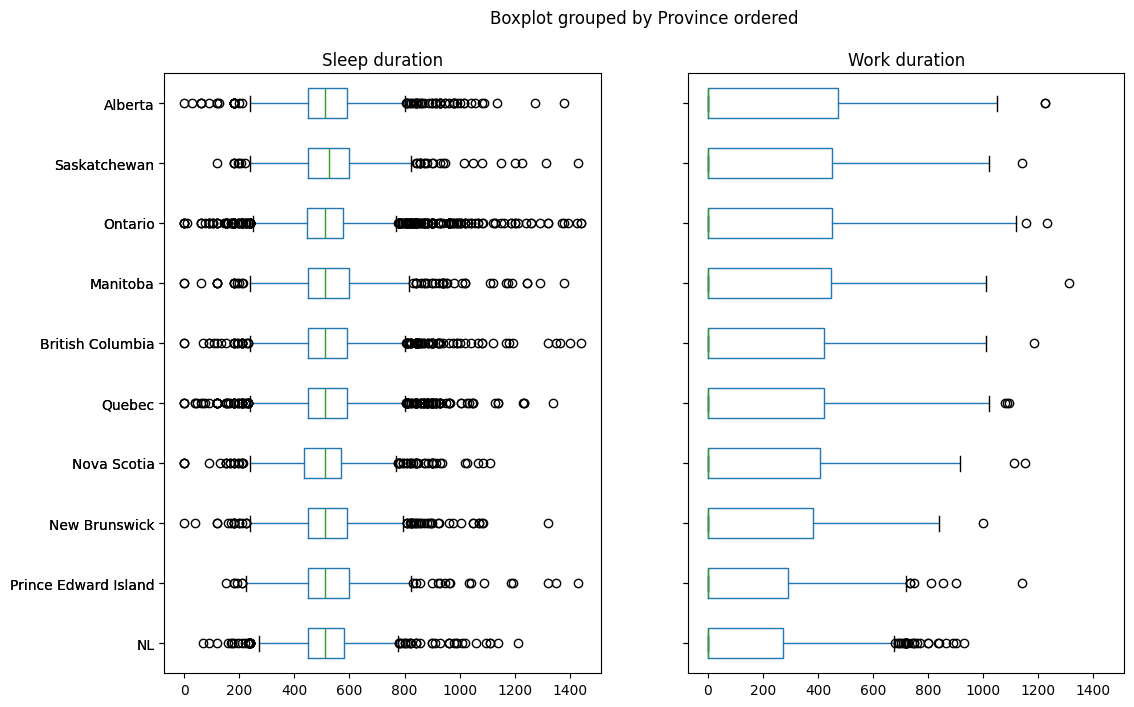Class 5: Data Transformations, Grouped Data, and Data Visualization#
Last class#
read in a csv file to
pandasselect rows and columns from a
pandas.DataFramerename columns of a
pandas.DataFrame
This class#
Transformations: create a new column in a
pandas.DataFrameData summaries: mean, median, and measures of variation
Data visualization: boxplots, histograms, and bar charts
Midterm Information#
Covers all the content we have covered up until this class.
A past test is available on the course website.
We have set up 2 x 2hr online midterm review sessions (Feb 6 & Feb 7) during which you can ask questions on the practice midterm. We strongly recommend you try the practice midterm before or during the review sessions.
The test was designed to be completed in 90 minutes.
The teaching team will post a link to the test by 09:00 AM, Feb. 11 on the course website.
You can submit anytime up until 11:00 AM on February 11.
The instructors will be available on a zoom link in case you have any questions from 09:00 AM - 11:00 AM. We will also be in the classroom, SS2118 for those who would like to use the space and in-person support.
Data Transformations#
Time in the time use survey is measured in minutes, but it’s not easy to interpret when the numbers get very large.
I worked four thousand six hundred thirty two minutes last week!
It would be easier if time was reported in hours.
I worked over seventy seven hours last week!
Converting time measured in minutes to time measured in hours is an example of a data transformation.
Time use survey#
import pandas as pd
time_use_data = pd.read_csv("gss_tu2016_main_file.csv")
time_use_data.head()
/var/folders/0j/ybsv4ncn5w50v40vdh5jjlww0000gn/T/ipykernel_15264/4239799222.py:1: DeprecationWarning:
Pyarrow will become a required dependency of pandas in the next major release of pandas (pandas 3.0),
(to allow more performant data types, such as the Arrow string type, and better interoperability with other libraries)
but was not found to be installed on your system.
If this would cause problems for you,
please provide us feedback at https://github.com/pandas-dev/pandas/issues/54466
import pandas as pd
| CASEID | pumfid | wght_per | survmnth | wtbs_001 | agecxryg | agegr10 | agehsdyc | ageprgrd | chh0014c | ... | ree_02 | ree_03 | rlr_110 | lan_01 | lanhome | lanhmult | lanmt | lanmtmul | incg1 | hhincg1 | |
|---|---|---|---|---|---|---|---|---|---|---|---|---|---|---|---|---|---|---|---|---|---|
| 0 | 10000 | 10000 | 616.6740 | 7 | 305.1159 | 96 | 5 | 62 | 96 | 0 | ... | 1 | 1 | 1 | 1 | 1 | 1 | 1 | 1 | 1 | 1 |
| 1 | 10001 | 10001 | 8516.6140 | 7 | 0.0000 | 6 | 5 | 32 | 5 | 0 | ... | 5 | 6 | 3 | 1 | 5 | 2 | 5 | 2 | 5 | 8 |
| 2 | 10002 | 10002 | 371.7520 | 1 | 362.7057 | 2 | 4 | 9 | 10 | 3 | ... | 5 | 1 | 1 | 1 | 1 | 1 | 1 | 1 | 3 | 8 |
| 3 | 10003 | 10003 | 1019.3135 | 3 | 0.0000 | 96 | 6 | 65 | 96 | 0 | ... | 3 | 2 | 2 | 1 | 1 | 1 | 1 | 1 | 2 | 2 |
| 4 | 10004 | 10004 | 1916.0708 | 9 | 11388.9706 | 96 | 2 | 25 | 96 | 0 | ... | 9 | 99 | 9 | 9 | 99 | 9 | 99 | 9 | 2 | 4 |
5 rows × 350 columns
Subset the data#
In this class we will explore the following columns. Let’s create a subset of time_use_data with only these columns:
(columns from last week)
CASEID: participant IDluc_rst: large urban centre vs rural and small townschh0014c: number of kids 14 or undergtu_110: feeling rushed
(plus…)
prv: province of residenceagegr10: age groupmarstat: marital statussex: sexdur01: duration spent sleepingdur08: duration spent working
important_columns = [
"CASEID",
"prv", "luc_rst", # place of residence
"agegr10", "marstat", "sex", # age, marital status, sex
"chh0014c", # kids < 14
"gtu_110", # feeling rushed
"dur01", "dur08" # time sleeping and working
]
subset_time_use_data = time_use_data[important_columns]
subset_time_use_data.head()
| CASEID | prv | luc_rst | agegr10 | marstat | sex | chh0014c | gtu_110 | dur01 | dur08 | |
|---|---|---|---|---|---|---|---|---|---|---|
| 0 | 10000 | 46 | 1 | 5 | 5 | 1 | 0 | 1 | 510 | 0 |
| 1 | 10001 | 59 | 1 | 5 | 1 | 1 | 0 | 3 | 420 | 0 |
| 2 | 10002 | 47 | 1 | 4 | 1 | 2 | 3 | 1 | 570 | 480 |
| 3 | 10003 | 35 | 1 | 6 | 5 | 2 | 0 | 2 | 510 | 20 |
| 4 | 10004 | 35 | 1 | 2 | 6 | 1 | 0 | 1 | 525 | 0 |
Rename columns so that they are meaningful#
Use the
renamefunction to rename columns.
# dictionary of "old name":"new name"
newnames = {
"CASEID": "Participant ID",
"luc_rst": "Urban/Rural",
"agegr10": "Age Group",
"marstat": "Marital Status",
"sex": "sex",
"chh0014c": "Kids under 14",
"gtu_110": "Feeling Rushed",
"dur01": "Sleep duration",
"dur08": "Work duration"
}
subset_time_use_data_colnames = subset_time_use_data.rename(columns = newnames)
subset_time_use_data_colnames.head()
| Participant ID | prv | Urban/Rural | Age Group | Marital Status | sex | Kids under 14 | Feeling Rushed | Sleep duration | Work duration | |
|---|---|---|---|---|---|---|---|---|---|---|
| 0 | 10000 | 46 | 1 | 5 | 5 | 1 | 0 | 1 | 510 | 0 |
| 1 | 10001 | 59 | 1 | 5 | 1 | 1 | 0 | 3 | 420 | 0 |
| 2 | 10002 | 47 | 1 | 4 | 1 | 2 | 3 | 1 | 570 | 480 |
| 3 | 10003 | 35 | 1 | 6 | 5 | 2 | 0 | 2 | 510 | 20 |
| 4 | 10004 | 35 | 1 | 2 | 6 | 1 | 0 | 1 | 525 | 0 |
Create a new column in a pandas DataFrame#
Create a new numeric column derived from another numeric column.
The code below creates a new column Sleep duration (hours) by dividing Sleep duration by 60, since 1 hour = 60 minutes.
subset_time_use_data_colnames # create a new column
subset_time_use_data_colnames.head()
| Participant ID | prv | Urban/Rural | Age Group | Marital Status | sex | Kids under 14 | Feeling Rushed | Sleep duration | Work duration | |
|---|---|---|---|---|---|---|---|---|---|---|
| 0 | 10000 | 46 | 1 | 5 | 5 | 1 | 0 | 1 | 510 | 0 |
| 1 | 10001 | 59 | 1 | 5 | 1 | 1 | 0 | 3 | 420 | 0 |
| 2 | 10002 | 47 | 1 | 4 | 1 | 2 | 3 | 1 | 570 | 480 |
| 3 | 10003 | 35 | 1 | 6 | 5 | 2 | 0 | 2 | 510 | 20 |
| 4 | 10004 | 35 | 1 | 2 | 6 | 1 | 0 | 1 | 525 | 0 |
subset_time_use_data_colnames["Sleep duration (hours)"] = subset_time_use_data_colnames["Sleep duration"] / 60
subset_time_use_data_colnames.head()
| Participant ID | prv | Urban/Rural | Age Group | Marital Status | sex | Kids under 14 | Feeling Rushed | Sleep duration | Work duration | Sleep duration (hours) | |
|---|---|---|---|---|---|---|---|---|---|---|---|
| 0 | 10000 | 46 | 1 | 5 | 5 | 1 | 0 | 1 | 510 | 0 | 8.50 |
| 1 | 10001 | 59 | 1 | 5 | 1 | 1 | 0 | 3 | 420 | 0 | 7.00 |
| 2 | 10002 | 47 | 1 | 4 | 1 | 2 | 3 | 1 | 570 | 480 | 9.50 |
| 3 | 10003 | 35 | 1 | 6 | 5 | 2 | 0 | 2 | 510 | 20 | 8.50 |
| 4 | 10004 | 35 | 1 | 2 | 6 | 1 | 0 | 1 | 525 | 0 | 8.75 |
What happened?#
To create a new column, use the [] brackets with the new column name at the left side of the assignment.
The calculation of the values is done element-wise. This means all values in the given column are divided by the value 60 at once. You do not need to use a loop to iterate each of the rows!

Reference is available here.
Transform a column using if-then#
The
Age Groupcolumn has the following distribution.
subset_time_use_data_colnames["Age Group"].value_counts()
Age Group
5 3741
6 2958
4 2789
3 2597
2 2127
7 1875
1 1303
Name: count, dtype: int64
It would be easier to interpret if the labels were used.
Age group of respondent (groups of 10)
VALUE LABEL
1 15 to 24 years
2 25 to 34 years
3 35 to 44 years
4 45 to 54 years
5 55 to 64 years
6 65 to 74 years
7 75 years and over
96 Valid skip
97 Don't know
98 Refusal
99 Not stated
Data type: numeric
Missing-data codes: 96-99
Record/column: 1/35
age_group_1 = subset_time_use_data_colnames["Age Group"] == 1
subset_time_use_data_colnames[age_group_1]
subset_time_use_data_colnames.loc[age_group_1, ["Age Group"]]
| Age Group | |
|---|---|
| 5 | 1 |
| 6 | 1 |
| 27 | 1 |
| 54 | 1 |
| 59 | 1 |
| ... | ... |
| 17341 | 1 |
| 17357 | 1 |
| 17374 | 1 |
| 17378 | 1 |
| 17385 | 1 |
1303 rows × 1 columns
# make a copy of the dataframe
subset_time_df = subset_time_use_data_colnames.copy()
# create a new column called "Age group label"
subset_time_df.loc[subset_time_df["Age Group"] == 1, "Age group label"] = "15-24"
subset_time_df.loc[subset_time_df["Age Group"] == 2, "Age group label"] = "25-34"
subset_time_df.loc[subset_time_df["Age Group"] == 3, "Age group label"] = "35-44"
subset_time_df.loc[subset_time_df["Age Group"] == 4, "Age group label"] = "45-54"
subset_time_df.loc[subset_time_df["Age Group"] == 5, "Age group label"] = "55-64"
subset_time_df.loc[subset_time_df["Age Group"] == 6, "Age group label"] = "65-74"
subset_time_df.loc[subset_time_df["Age Group"] == 7, "Age group label"] = "75+"
subset_time_df.head()
| Participant ID | prv | Urban/Rural | Age Group | Marital Status | sex | Kids under 14 | Feeling Rushed | Sleep duration | Work duration | Sleep duration (hours) | Age group label | |
|---|---|---|---|---|---|---|---|---|---|---|---|---|
| 0 | 10000 | 46 | 1 | 5 | 5 | 1 | 0 | 1 | 510 | 0 | 8.50 | 55-64 |
| 1 | 10001 | 59 | 1 | 5 | 1 | 1 | 0 | 3 | 420 | 0 | 7.00 | 55-64 |
| 2 | 10002 | 47 | 1 | 4 | 1 | 2 | 3 | 1 | 570 | 480 | 9.50 | 45-54 |
| 3 | 10003 | 35 | 1 | 6 | 5 | 2 | 0 | 2 | 510 | 20 | 8.50 | 65-74 |
| 4 | 10004 | 35 | 1 | 2 | 6 | 1 | 0 | 1 | 525 | 0 | 8.75 | 25-34 |
What happened?#

To create a new column in a pandas DataFrame using if-then/if-then-else logic#
This line
`subset_time_df.loc[subset_time_df[“Age Group”] == 1, “Age group label”] = “15-24”
creates a new column in subset_time_df called Age group label according to the if-then (conditional) logic:
If subset_time_df["Age Group"] == 1 then Age group label is assigned the value 15-24.
This line
subset_time_df.loc[subset_time_df["Age Group"] == 2, 'Age group label'] = "25-34"
does the else if logic. Namely,
If subset_time_df["Age Group"] == 2 then Age group label is assigned the value 25-34.
This line
subset_time_df.loc[subset_time_df["Age Group"] == 3, "Age group label"] = "35-44"
does the else if logic. Namely,
If subset_time_df["Age Group"] == 3 then Age group label is assigned the value 35-44.
etc …
See idioms in the Pandas cookbook and a reference on different ways to subset a pandas DataFrame.
Merging pandas DataFrames#
We want would like to look at the relationship between sleeping and working, on different aspects of time use at the provincial level. In addition we would like to add provincial level data of on income and housing.
The data is in
provincial_data.csv.
prov_data = pd.read_csv("provincial_data.csv")
prov_data
| COL0 | COL1 | COL2 | COL3 | COL4 | |
|---|---|---|---|---|---|
| 0 | 1 | 60.2 | 70336.0 | 2.4 | 16.6 |
| 1 | 10 | 49.5 | 67272.0 | 2.3 | 10.6 |
| 2 | 11 | 58.2 | 61163.0 | 2.3 | 11.1 |
| 3 | 12 | 55.2 | 60764.0 | 2.3 | 12.0 |
| 4 | 13 | 54.6 | 59347.0 | 2.3 | 10.3 |
| 5 | 24 | 59.5 | 59822.0 | 2.3 | 12.9 |
| 6 | 35 | 59.9 | 74287.0 | 2.6 | 19.8 |
| 7 | 46 | 61.7 | 68147.0 | 2.5 | 11.4 |
| 8 | 47 | 63.5 | 75412.0 | 2.5 | 12.1 |
| 9 | 48 | 65.4 | 93835.0 | 2.6 | 15.1 |
| 10 | 59 | 59.6 | 69995.0 | 2.4 | 20.7 |
| 11 | 60 | 68.5 | 84521.0 | 2.3 | 12.7 |
| 12 | 61 | 66.2 | 117688.0 | 2.7 | 9.0 |
| 13 | 62 | 53.6 | 97441.0 | 3.6 | 7.9 |
COL0 - GEO UID
COL1 - Labour - Total Sex / Employment rate
COL2 - Income - Total Sex / Total - Income statistics in 2015 for private households by household size - 100% data / Median total income of households in 2015 ($)
COL3 - Dwelling characteristics / Average household size
COL4 - Housing - Total Sex / Total - Owner households in non-farm, non-reserve private dwellings - 25% sample data / % of owner households spending 30% or more of its income on shelter costs
Let’s give the columns meaningful names.
colnames = {"COL0": "Prov",
"COL1": "Employment Rate",
"COL2": "Income",
"COL3": "Household Size",
"COL4": "Pct house over 30"}
prov_data.rename(columns=colnames, inplace=True)
# inplace=True applies the column name change to the current DataFrame
prov_data
| Prov | Employment Rate | Income | Household Size | Pct house over 30 | |
|---|---|---|---|---|---|
| 0 | 1 | 60.2 | 70336.0 | 2.4 | 16.6 |
| 1 | 10 | 49.5 | 67272.0 | 2.3 | 10.6 |
| 2 | 11 | 58.2 | 61163.0 | 2.3 | 11.1 |
| 3 | 12 | 55.2 | 60764.0 | 2.3 | 12.0 |
| 4 | 13 | 54.6 | 59347.0 | 2.3 | 10.3 |
| 5 | 24 | 59.5 | 59822.0 | 2.3 | 12.9 |
| 6 | 35 | 59.9 | 74287.0 | 2.6 | 19.8 |
| 7 | 46 | 61.7 | 68147.0 | 2.5 | 11.4 |
| 8 | 47 | 63.5 | 75412.0 | 2.5 | 12.1 |
| 9 | 48 | 65.4 | 93835.0 | 2.6 | 15.1 |
| 10 | 59 | 59.6 | 69995.0 | 2.4 | 20.7 |
| 11 | 60 | 68.5 | 84521.0 | 2.3 | 12.7 |
| 12 | 61 | 66.2 | 117688.0 | 2.7 | 9.0 |
| 13 | 62 | 53.6 | 97441.0 | 3.6 | 7.9 |
Now, we are ready to use the merge function in pandas.
prov_data_df = subset_time_df.merge(
prov_data,
right_on="Prov", # the right data frame is prov_data
left_on="prv" # the left data frame is subset_time_df
)
prov_data_df.head()
| Participant ID | prv | Urban/Rural | Age Group | Marital Status | sex | Kids under 14 | Feeling Rushed | Sleep duration | Work duration | Sleep duration (hours) | Age group label | Prov | Employment Rate | Income | Household Size | Pct house over 30 | |
|---|---|---|---|---|---|---|---|---|---|---|---|---|---|---|---|---|---|
| 0 | 10000 | 46 | 1 | 5 | 5 | 1 | 0 | 1 | 510 | 0 | 8.50 | 55-64 | 46 | 61.7 | 68147.0 | 2.5 | 11.4 |
| 1 | 10001 | 59 | 1 | 5 | 1 | 1 | 0 | 3 | 420 | 0 | 7.00 | 55-64 | 59 | 59.6 | 69995.0 | 2.4 | 20.7 |
| 2 | 10002 | 47 | 1 | 4 | 1 | 2 | 3 | 1 | 570 | 480 | 9.50 | 45-54 | 47 | 63.5 | 75412.0 | 2.5 | 12.1 |
| 3 | 10003 | 35 | 1 | 6 | 5 | 2 | 0 | 2 | 510 | 20 | 8.50 | 65-74 | 35 | 59.9 | 74287.0 | 2.6 | 19.8 |
| 4 | 10004 | 35 | 1 | 2 | 6 | 1 | 0 | 1 | 525 | 0 | 8.75 | 25-34 | 35 | 59.9 | 74287.0 | 2.6 | 19.8 |
Is time spent resting different by province?#
Grouped summaries of data#
Many times we will want to calculate means, proportions, and other statistics by group membership.
This is so common that
pandashas a built-in function calledgroupbythat groups a data frame by another variable.
prov_data_df.head()
| Participant ID | prv | Urban/Rural | Age Group | Marital Status | sex | Kids under 14 | Feeling Rushed | Sleep duration | Work duration | Sleep duration (hours) | Age group label | Prov | Employment Rate | Income | Household Size | Pct house over 30 | |
|---|---|---|---|---|---|---|---|---|---|---|---|---|---|---|---|---|---|
| 0 | 10000 | 46 | 1 | 5 | 5 | 1 | 0 | 1 | 510 | 0 | 8.50 | 55-64 | 46 | 61.7 | 68147.0 | 2.5 | 11.4 |
| 1 | 10001 | 59 | 1 | 5 | 1 | 1 | 0 | 3 | 420 | 0 | 7.00 | 55-64 | 59 | 59.6 | 69995.0 | 2.4 | 20.7 |
| 2 | 10002 | 47 | 1 | 4 | 1 | 2 | 3 | 1 | 570 | 480 | 9.50 | 45-54 | 47 | 63.5 | 75412.0 | 2.5 | 12.1 |
| 3 | 10003 | 35 | 1 | 6 | 5 | 2 | 0 | 2 | 510 | 20 | 8.50 | 65-74 | 35 | 59.9 | 74287.0 | 2.6 | 19.8 |
| 4 | 10004 | 35 | 1 | 2 | 6 | 1 | 0 | 1 | 525 | 0 | 8.75 | 25-34 | 35 | 59.9 | 74287.0 | 2.6 | 19.8 |
grouped_by_prov = prov_data_df.groupby("Prov") #group the DataFrame by prov
type(grouped_by_prov)
pandas.core.groupby.generic.DataFrameGroupBy
rest_by_prov_mean = grouped_by_prov["Sleep duration (hours)"].mean()
rest_by_prov_mean
Prov
10 8.651739
11 8.901090
12 8.500917
13 8.722338
24 8.759245
35 8.612381
46 8.829857
47 8.824515
48 8.710498
59 8.808136
Name: Sleep duration (hours), dtype: float64
rest_by_prov_mean is a pandas Series with indexed by Prov.
type(rest_by_prov_mean)
pandas.core.series.Series
DataFrame Index#
rest_by_prov_mean.index
Index([10, 11, 12, 13, 24, 35, 46, 47, 48, 59], dtype='int64', name='Prov')
From the
prv Province of residence
VALUE LABEL
10 Newfoundland and Labroador
11 Prince Edward Island
12 Nova Scotia
13 New Brunswick
24 Quebec
35 Ontario
46 Manitoba
47 Saskatchewan
48 Alberta
59 British Columbia
96 Valid skip
97 Don't know
98 Refusal
99 Not stated
Data type: numeric
Missing-data codes: 96-99
Record/columns: 1/57-58
We can reindex rest_by_prov_mean.
index_new = [
"Newfoundland and Labrador",
"Prince Edward Island",
"Nova Scotia",
"New Brunswick",
"Quebec",
"Ontario",
"Manitoba",
"Saskatchewan",
"Alberta",
"British Columbia"
]
rest_by_prov_mean.index = index_new
rest_by_prov_mean
Newfoundland and Labrador 8.651739
Prince Edward Island 8.901090
Nova Scotia 8.500917
New Brunswick 8.722338
Quebec 8.759245
Ontario 8.612381
Manitoba 8.829857
Saskatchewan 8.824515
Alberta 8.710498
British Columbia 8.808136
Name: Sleep duration (hours), dtype: float64
Let’s also create a new column Prov label in prov_data_df.
prov_data_df.loc[prov_data_df["Prov"] == 10, "Prov label"] = "NL"
prov_data_df.loc[prov_data_df["Prov"] == 11, "Prov label"] = "Prince Edward Island"
prov_data_df.loc[prov_data_df["Prov"] == 12, "Prov label"] = "Nova Scotia"
prov_data_df.loc[prov_data_df["Prov"] == 13, "Prov label"] = "New Brunswick"
prov_data_df.loc[prov_data_df["Prov"] == 24, "Prov label"] = "Quebec"
prov_data_df.loc[prov_data_df["Prov"] == 35, "Prov label"] = "Ontario"
prov_data_df.loc[prov_data_df["Prov"] == 46, "Prov label"] = "Manitoba"
prov_data_df.loc[prov_data_df["Prov"] == 47, "Prov label"] = "Saskatchewan"
prov_data_df.loc[prov_data_df["Prov"] == 48, "Prov label"] = "Alberta"
prov_data_df.loc[prov_data_df["Prov"] == 59, "Prov label"] = "British Columbia"
prov_data_df.loc[prov_data_df["Prov"] >= 96, "Prov label"] = None
prov_data_df.head()
| Participant ID | prv | Urban/Rural | Age Group | Marital Status | sex | Kids under 14 | Feeling Rushed | Sleep duration | Work duration | Sleep duration (hours) | Age group label | Prov | Employment Rate | Income | Household Size | Pct house over 30 | Prov label | |
|---|---|---|---|---|---|---|---|---|---|---|---|---|---|---|---|---|---|---|
| 0 | 10000 | 46 | 1 | 5 | 5 | 1 | 0 | 1 | 510 | 0 | 8.50 | 55-64 | 46 | 61.7 | 68147.0 | 2.5 | 11.4 | Manitoba |
| 1 | 10001 | 59 | 1 | 5 | 1 | 1 | 0 | 3 | 420 | 0 | 7.00 | 55-64 | 59 | 59.6 | 69995.0 | 2.4 | 20.7 | British Columbia |
| 2 | 10002 | 47 | 1 | 4 | 1 | 2 | 3 | 1 | 570 | 480 | 9.50 | 45-54 | 47 | 63.5 | 75412.0 | 2.5 | 12.1 | Saskatchewan |
| 3 | 10003 | 35 | 1 | 6 | 5 | 2 | 0 | 2 | 510 | 20 | 8.50 | 65-74 | 35 | 59.9 | 74287.0 | 2.6 | 19.8 | Ontario |
| 4 | 10004 | 35 | 1 | 2 | 6 | 1 | 0 | 1 | 525 | 0 | 8.75 | 25-34 | 35 | 59.9 | 74287.0 | 2.6 | 19.8 | Ontario |
Summing across rows of a DataFrame#
How much time is spent by each respondent sleeping and working?
The average time spent sleeping and working by province is:
restwork_by_prov_mean = prov_data_df.groupby("Prov label")[["Sleep duration", "Work duration"]].mean()
restwork_by_prov_mean
| Sleep duration | Work duration | |
|---|---|---|
| Prov label | ||
| Alberta | 522.629888 | 199.491620 |
| British Columbia | 528.488161 | 165.233753 |
| Manitoba | 529.791411 | 175.156442 |
| NL | 519.104339 | 133.946281 |
| New Brunswick | 523.340265 | 148.428166 |
| Nova Scotia | 510.055019 | 158.398649 |
| Ontario | 516.742869 | 177.705566 |
| Prince Edward Island | 534.065385 | 134.126923 |
| Quebec | 525.554724 | 159.450461 |
| Saskatchewan | 529.470905 | 182.572198 |
Two different ways to calulate row totals#
There are more but we will focus on the two methods.
We would like to calculate the total mean time spent sleeping and working.
restwork_by_prov_mean["Total1"] = restwork_by_prov_mean["Sleep duration"] + restwork_by_prov_mean["Work duration"]
restwork_by_prov_mean.head()
| Sleep duration | Work duration | Total1 | |
|---|---|---|---|
| Prov label | |||
| Alberta | 522.629888 | 199.491620 | 722.121508 |
| British Columbia | 528.488161 | 165.233753 | 693.721914 |
| Manitoba | 529.791411 | 175.156442 | 704.947853 |
| NL | 519.104339 | 133.946281 | 653.050620 |
| New Brunswick | 523.340265 | 148.428166 | 671.768431 |
restwork_by_prov_mean["Total2"] = restwork_by_prov_mean[["Sleep duration","Work duration"]].sum(
axis=1 # sum across all columns
)
restwork_by_prov_mean.head()
| Sleep duration | Work duration | Total1 | Total2 | |
|---|---|---|---|---|
| Prov label | ||||
| Alberta | 522.629888 | 199.491620 | 722.121508 | 722.121508 |
| British Columbia | 528.488161 | 165.233753 | 693.721914 | 693.721914 |
| Manitoba | 529.791411 | 175.156442 | 704.947853 | 704.947853 |
| NL | 519.104339 | 133.946281 | 653.050620 | 653.050620 |
| New Brunswick | 523.340265 | 148.428166 | 671.768431 | 671.768431 |
In pandas
axis=1refers to columns andaxis=0refers to rows.DataFrame.sum(axis=1): sum across columnsDataFrame.sum(axis=0): sum across rows.
Statistical Variables#
Categorical variable
- A categorical variable is a variable for which the measurement scale consists of a set of categories.
- For example, time use has ten categories, or levels.
- These types of variables are very common in social and biomedical sciences, and many other areas.

Nominal variable
- Categorical variables that don't have a natural ordering is called a nominal variable.
- For example, Canadian provinces are nominal.

Ordinal variable
- If a categorical variable has a natural ordering, it is called an ordinal variable.
- For example, if levels
96(valid skip),97(don't know),98(refusal),99(not stated) are removed fromgtu_110then time use woudl be considered an ordinal variable since it's ordered from feeling rushedEveryday(1) to feeling rushedNever(6). - Ordinal variables clearly order categories, but the "distance" between categories are unknown/meaningless.

Quantitative variable
- A quantitative variable consists of numerical measurements.

Interval variable
- An interval variable has numerical differences, but there is no relative scale and 0 holds no meaning.
- For example, absolute differences between 20℃ and 30℃, and between 10℃ and 20℃ are the same while relative differences between 15℃ and 30℃, and between 10℃ and 20℃ are not.
- This is because a 0 value is arbitrary. 0℃ does not mean "no temperature".

An interval variable is one that does have numerical distances between any two levels of the measurement scale. For example, calendar years is an interval variable.
Ratio variable
- A ratio variable has both numerical differences and relative scales. A 0 holds semantic meaning.
- Time use in minutes and age in years are examples of ratio (statistical) variables.
- Time use of 0 minute means no time spent.

What’s the difference between a Statistical Variable and a Variable in python?#
A variable in python is a location in computer memory to store a value.
A statistical variable is essentially a mathematical representation of data.
Examples of implementing statistical variables in python#
If 10 people are randomly selected, and asked how many minutes they slept last night, then this data could be represented by an ratio variable.
In python the data could be represented in
pandas.Series, where theSeriesdata type is float.
If 10 people are randomly selected, and asked if they live in urban or rural areas, then this data could be represented by an categorical variable.
In python the data could be represented in
pandas.Series, where theSeriesdata type is Boolean (Trueif urban, andFalseif not urban).
Statistical Distributions#
What is a statistical distribution?
How can a distribution be summarized?
What questions can we answer using a distribution?
What is the distribution of kids under 14 in Ontario?#
Select rows in
prov_data_dfwhereProv labelisOntarioSelect the column
Kids under 14Compute the number of respondents who have 0 kids, 1 kid, etc. using
.value_counts()
Ontkidsdist = prov_data_df.loc[
prov_data_df["Prov label"] == "Ontario",
"Kids under 14"
].value_counts()
Ontkidsdist
Kids under 14
0 3918
1 508
2 430
3 157
Name: count, dtype: int64
type(Ontkidsdist)
pandas.core.series.Series
A bar plot of the distribution of kids under 14 in Ontario#
Ontkidsdist.plot.bar();
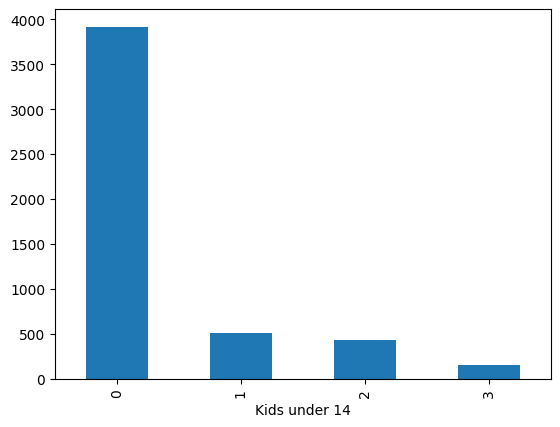
If we want to plot proportions instead of counts then we can transform Ontkidsdist by dividing by the total number of observations.
Ontkidsdist_prop = Ontkidsdist / Ontkidsdist.sum()
Ontkidsdist_prop
Kids under 14
0 0.781568
1 0.101337
2 0.085777
3 0.031319
Name: count, dtype: float64
Ontkidsdist_prop.plot.bar();
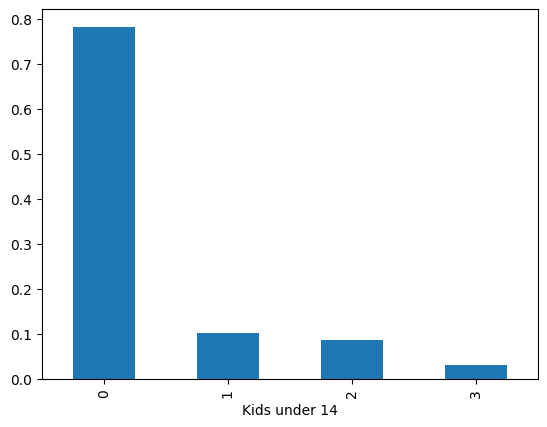
Distribution of counts by province
prov_data_df.groupby(["Prov label"])["Kids under 14"].value_counts()
Prov label Kids under 14
Alberta 0 1077
1 152
2 145
3 58
British Columbia 0 1672
1 145
2 132
3 36
Manitoba 0 763
1 93
2 88
3 34
NL 0 766
1 103
2 84
3 15
New Brunswick 0 875
2 79
1 77
3 27
Nova Scotia 0 858
2 86
1 77
3 15
Ontario 0 3918
1 508
2 430
3 157
Prince Edward Island 0 432
1 43
2 30
3 15
Quebec 0 2755
2 305
1 300
3 112
Saskatchewan 0 716
1 89
2 79
3 44
Name: count, dtype: int64
# an exmaple of a bad plot
prov_data_df.groupby(["Prov label"])["Kids under 14"].value_counts().plot.bar();
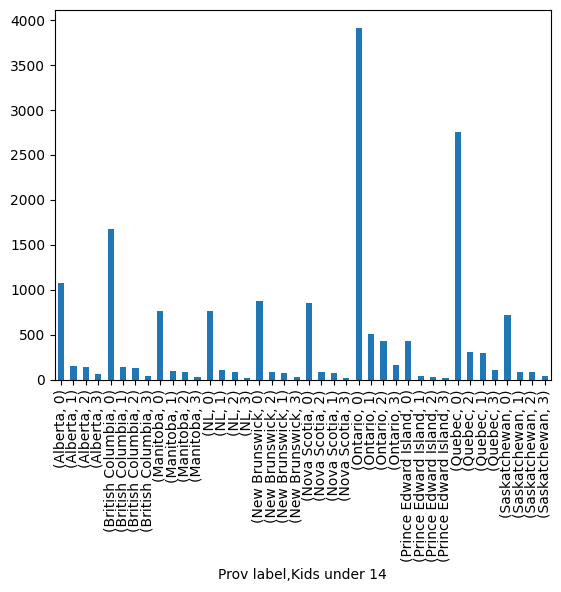
# ----- WON'T BE TESTED -----
# the code below is beyond what will be tested and is provided for the purpose
# of demonstrating examples of visualizations that achieve different goals
# You can "unstack" the index an create a better view to achieve different goals.
prov_kids14_dist_df = prov_data_df.groupby(["Prov label"])["Kids under 14"].value_counts()
prov_kids14_dist_unstacked_df = prov_kids14_dist_df.unstack(level=1)
# using "df.plot.barh()" to plot horizontal bars to compari proportions
prov_kids14_totals = prov_kids14_dist_unstacked_df.sum(axis=1)
prov_kids14_dist_unstacked_df["None"] = prov_kids14_dist_unstacked_df[0] / prov_kids14_totals
prov_kids14_dist_unstacked_df["One"] = prov_kids14_dist_unstacked_df[1] / prov_kids14_totals
prov_kids14_dist_unstacked_df["Two"] = prov_kids14_dist_unstacked_df[2] / prov_kids14_totals
prov_kids14_dist_unstacked_df["Three or more"] = prov_kids14_dist_unstacked_df[3] / prov_kids14_totals
## comparing within provinces
prov_kids14_dist_unstacked_df[["None", "One", "Two", "Three or more"]].plot.barh()
## comparing between provinces
prov_kids14_dist_unstacked_df[["None", "One", "Two", "Three or more"]].plot.barh(stacked=True)
<Axes: ylabel='Prov label'>
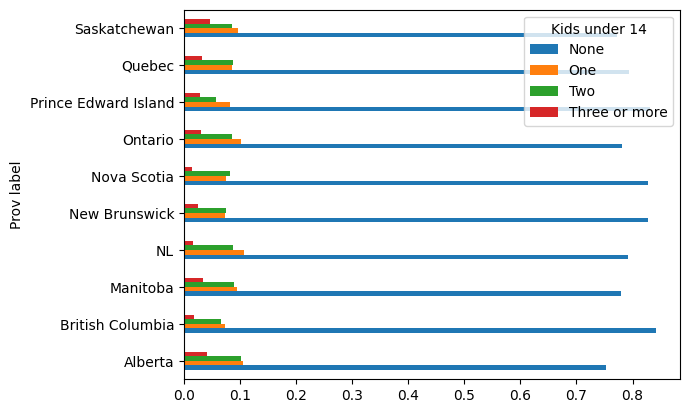
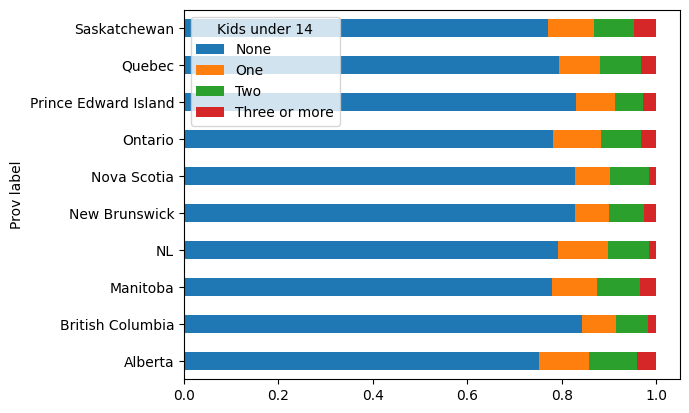
# ----- WON'T BE TESTED -----
# the code below is beyond what will be tested and is provided for the purpose
# of demonstrating examples of visualizations that achieve different goals
# using "matplotlib" to create "subplots" - will briefly cover in Week 10
# ustack provinces instead of responses
prov_kids14_dist_unstacked_prov_df = prov_kids14_dist_df.unstack(level=0)
prov_kids14_dist_with_ch14_df = prov_kids14_dist_unstacked_prov_df.loc[[1, 2, 3]] # only compare the distribution with 1 or more children
prov_kids14_dist_with_ch14_df = prov_kids14_dist_with_ch14_df / prov_kids14_dist_with_ch14_df.sum(axis=0) # get proportions
# prov_kids14_dist_with_ch14_df.loc[1].sort_values() # check the order by # participants with 1 child < 14
import matplotlib.pyplot as plt
fig, axes = plt.subplots(nrows=3, ncols=4, figsize = (12,12))
# row 1, column 1
ax = axes[0][0]
prov_kids14_dist_with_ch14_df["Quebec"].plot(ax=ax, kind="bar", rot=0)
ax.set_title("Quebec")
ax.set_xticklabels(["1", "2", "3+"])
ax.set_xlabel("")
ax.set_ylim([0, 0.6])
# row 1, column 2
ax = axes[0][1]
prov_kids14_dist_with_ch14_df["Saskatchewan"].plot(ax=ax, kind="bar", rot=0)
ax.set_title("Saskatchewan")
ax.set_xticklabels(["1", "2", "3+"])
ax.set_xlabel("")
ax.set_ylim([0, 0.6])
# row 1, column 3
ax = axes[0][2]
prov_kids14_dist_with_ch14_df["New Brunswick"].plot(ax=ax, kind="bar", rot=0)
ax.set_title("New Brunswick")
ax.set_xticklabels(["1", "2", "3+"])
ax.set_xlabel("")
ax.set_ylim([0, 0.6])
# row 1, column 4
ax = axes[0][3]
prov_kids14_dist_with_ch14_df["Alberta"].plot(ax=ax, kind="bar", rot=0)
ax.set_title("Alberta")
ax.set_xticklabels(["1", "2", "3+"])
ax.set_xlabel("")
ax.set_ylim([0, 0.6])
# row 2, column 1
ax = axes[1][0]
prov_kids14_dist_with_ch14_df["Manitoba"].plot(ax=ax, kind="bar", rot=0)
ax.set_title("Manitoba")
ax.set_xticklabels(["1", "2", "3+"])
ax.set_xlabel("")
ax.set_ylim([0, 0.6])
# row 2, column 2
ax = axes[1][1]
prov_kids14_dist_with_ch14_df["Nova Scotia"].plot(ax=ax, kind="bar", rot=0)
ax.set_title("Nova Scotia")
ax.set_xticklabels(["1", "2", "3+"])
ax.set_xlabel("")
ax.set_ylim([0, 0.6])
# row 2, column 3
ax = axes[1][2]
prov_kids14_dist_with_ch14_df["British Columbia"].plot(ax=ax, kind="bar", rot=0)
ax.set_title("British Columbia")
ax.set_xticklabels(["1", "2", "3+"])
ax.set_xlabel("")
ax.set_ylim([0, 0.6])
# row 2, column 4
ax = axes[1][3]
prov_kids14_dist_with_ch14_df["Ontario"].plot(ax=ax, kind="bar", rot=0)
ax.set_title("Ontario")
ax.set_xticklabels(["1", "2", "3+"])
ax.set_xlabel("")
ax.set_ylim([0, 0.6])
# row 3, column 1
ax = axes[2][0]
prov_kids14_dist_with_ch14_df["Prince Edward Island"].plot(ax=ax, kind="bar", rot=0)
ax.set_title("Prince Edward Island")
ax.set_xticklabels(["1", "2", "3+"])
ax.set_xlabel("")
ax.set_ylim([0, 0.6])
# row 3, column 2
ax = axes[2][1]
prov_kids14_dist_with_ch14_df["NL"].plot(ax=ax, kind="bar", rot=0)
ax.set_title("NL")
ax.set_xticklabels(["1", "2", "3+"])
ax.set_xlabel("")
ax.set_ylim([0, 0.6])
fig.delaxes(axes[2][2])
fig.delaxes(axes[2][3])
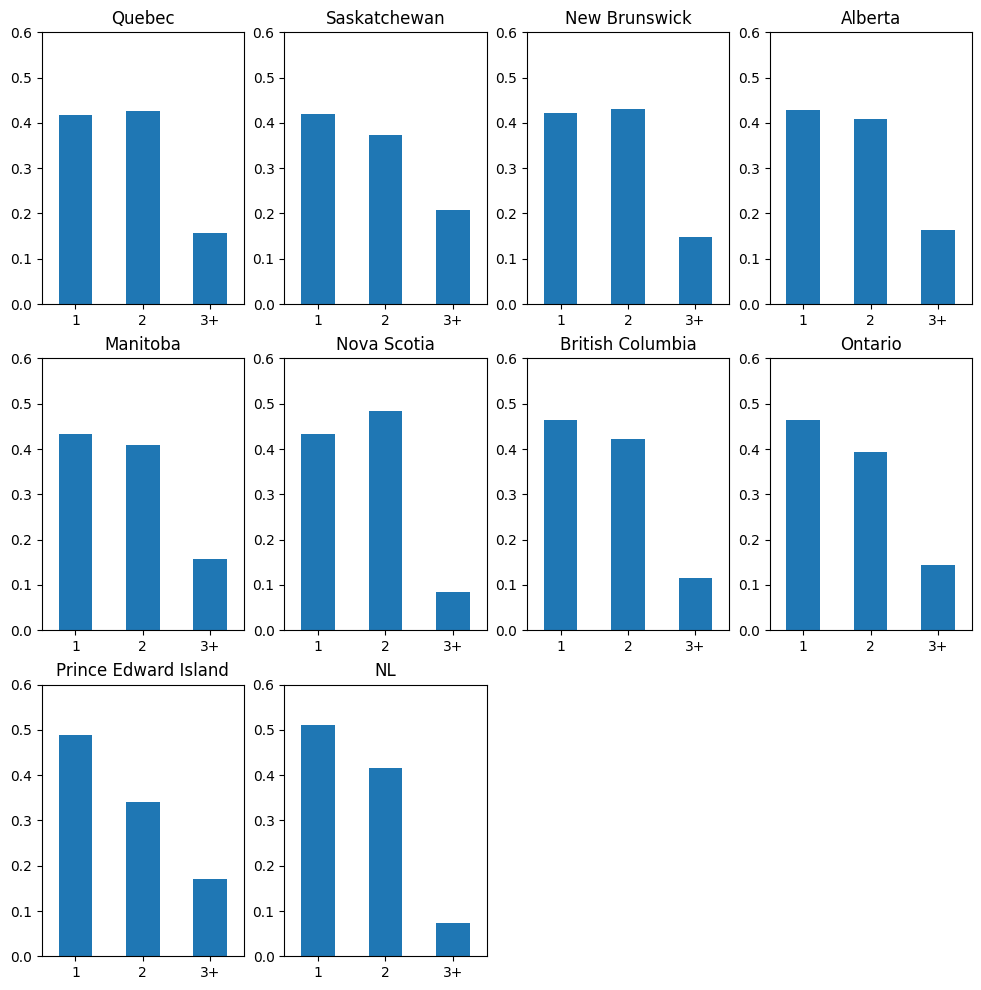
Summarizing the distribution of a quantitative variable#
dur01 is time spent sleeping, resting, etc.
dur01 Duration - Sleeping, resting, relaxing, sick in bed
VALUE LABEL
0 No time spent doing this activity
9996 Valid skip
9997 Don't know
9998 Refusal
9999 Not stated
Data type: numeric
Missing-data codes: 9996-9999
Record/columns: 1/65-68
Sleepduration = prov_data_df["Sleep duration (hours)"]
print(type(Sleepduration))
Sleepduration.dtypes
<class 'pandas.core.series.Series'>
dtype('float64')
Sleepduration.describe()
count 17390.000000
mean 8.706552
std 2.217733
min 0.000000
25% 7.500000
50% 8.500000
75% 9.750000
max 24.000000
Name: Sleep duration (hours), dtype: float64
The distributions of quantitative variables are often described as:
a measure of centre such as mean, median, and mode
a measure of spread such as standard deviation and inter-quartile range
a measure of range - the largest value minus the smallest value (or max - min)
Quantiles#
The median value is the 50% quantile. 50% of the values fall below this value. The median is also called the second quartile.
The 25% quantile is the value where 25% of the values fall below. This is often the first quartile (Q1)
The 75% quantile is the value where 75% of the values fall below. This is often the third quartile (Q3)
There are 17390 values. If we sort sleep duration values from largest to smallest then find the value in the middle (17390 / 2 = 8695) then that value is the median.
Variation#
One of the most important concepts in statistical reasoning.
Standard deviation is average deviation from the mean. Large values mean large variation and small values mean small variation.
Small samples often have large variation, so estimating a statistic from a small sample is usually less reliable.
Question#
A certain town is served by two hospitals. In the larger hospital about 45 babies are born each day, and in the smaller hospital about 15 babies are born each day. As you know, about 50% of all babies are boys. However, the exact percentage varies from day to day. Sometimes it may be higher than 50%, sometimes lower.
For a period of 1 year, each hospital recorded the days on which more than 60% of the babies born were boys. Which hospital do you think recorded more such days?
The larger hospital
The smaller hospital
About the same (that is, within 5% of each other)
Histograms#
Histograms display the frequency distribution of a quantitative variable.
Sleepduration_hist = Sleepduration.plot.hist(
bins=10,
edgecolor="black",
color="grey",
figsize = (8, 6)
);
Sleepduration_hist.set_xlabel("Sleep duration (hours)");
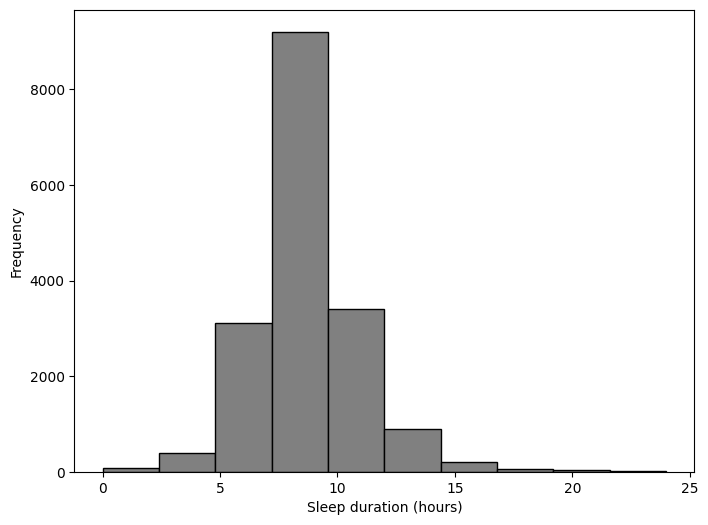
pd.cut(Sleepduration, bins=10)
0 (7.2, 9.6]
1 (4.8, 7.2]
2 (7.2, 9.6]
3 (7.2, 9.6]
4 (7.2, 9.6]
...
17385 (7.2, 9.6]
17386 (9.6, 12.0]
17387 (7.2, 9.6]
17388 (12.0, 14.4]
17389 (7.2, 9.6]
Name: Sleep duration (hours), Length: 17390, dtype: category
Categories (10, interval[float64, right]): [(-0.024, 2.4] < (2.4, 4.8] < (4.8, 7.2] < (7.2, 9.6] ... (14.4, 16.8] < (16.8, 19.2] < (19.2, 21.6] < (21.6, 24.0]]
Boxplots#
Another way to visualize the distribution of a quantitative variable
A box plot is a method for graphically depicting groups of numerical data through their quartiles.
The box extends from the Q1 to Q3 quartile values of the data, with a line at the median (Q2).
The whiskers extend from the edges of box to show the range of the data.
By default, they extend no more than 1.5 * IQR (IQR = Q3 - Q1) from the edges of the box, ending at the farthest data point within that interval. Outliers are plotted as separate dots.
Sleepduration_boxplot = Sleepduration.plot.box(figsize = (10,8));
Sleepduration_boxplot;
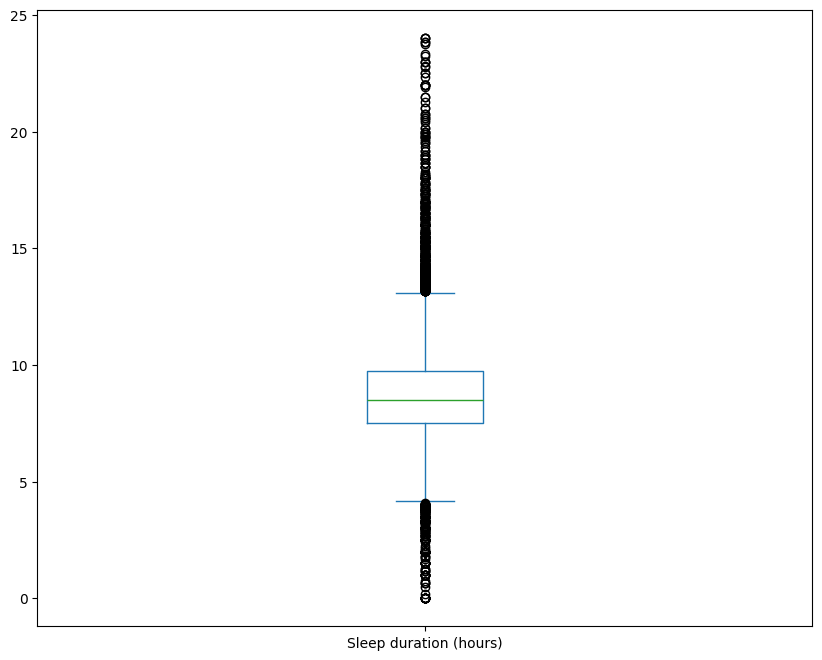
Anatomy of a Boxplot#
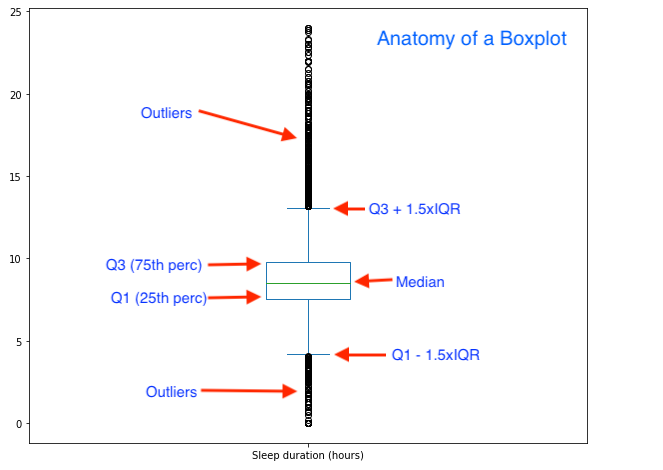
Two pandas methods to create a boxplot are:
pandas.DataFrame.plot.box: plot a Series or columns of a DataFramepandas.DataFrame.boxplot: plot the columns of a DataFrame with easy to use syntax for boxplots by a group.
Boxplots are helpful for comparing the distributions between groups.
Sleephours_boxplot = prov_data_df.boxplot(
column="Sleep duration (hours)",
by="Prov label",
figsize=(10,8),
vert=False,
# rot = 45,
grid=False
);
Sleephours_boxplot;
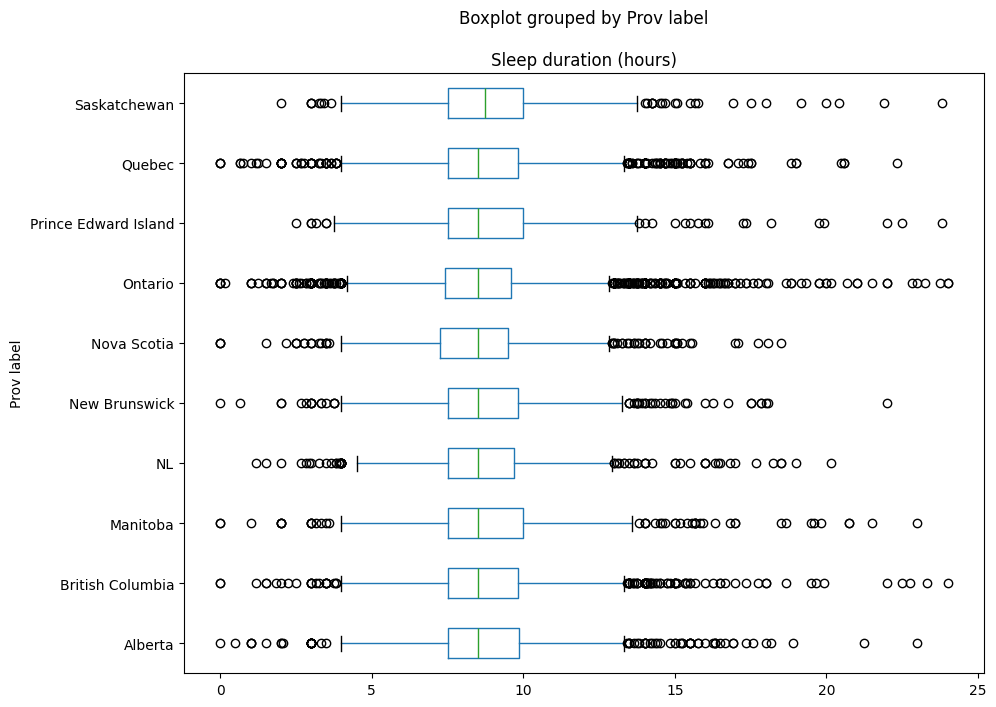
Compare the distribution of Sleep duration and Work duration by specifying the column parameter of DataFrame.boxplot as a list.
Sleepwork_boxplot = prov_data_df.boxplot(
column = ["Sleep duration", "Work duration"],
by = "Prov label",
figsize = (10,8),
# rot = 90,
vert=False,
grid = False,
layout = (1,2)
);
Sleepwork_boxplot;
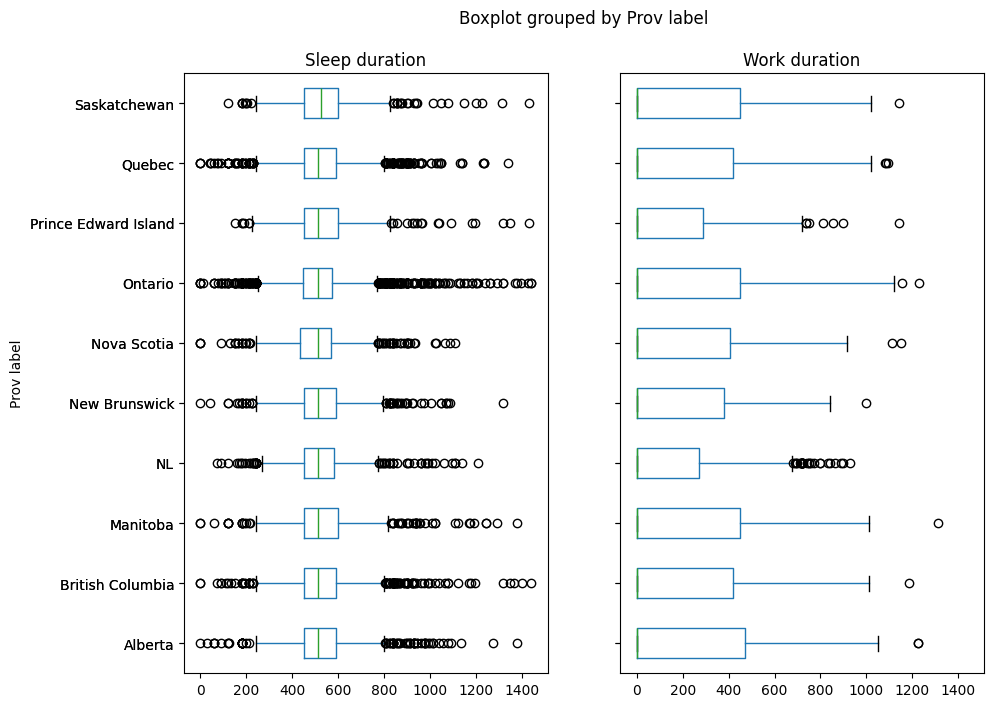
To further customize the look of your plots, see the documentation.
restwork_by_prov_mean.sort_values("Work duration")
| Sleep duration | Work duration | Total1 | Total2 | |
|---|---|---|---|---|
| Prov label | ||||
| NL | 519.104339 | 133.946281 | 653.050620 | 653.050620 |
| Prince Edward Island | 534.065385 | 134.126923 | 668.192308 | 668.192308 |
| New Brunswick | 523.340265 | 148.428166 | 671.768431 | 671.768431 |
| Nova Scotia | 510.055019 | 158.398649 | 668.453668 | 668.453668 |
| Quebec | 525.554724 | 159.450461 | 685.005184 | 685.005184 |
| British Columbia | 528.488161 | 165.233753 | 693.721914 | 693.721914 |
| Manitoba | 529.791411 | 175.156442 | 704.947853 | 704.947853 |
| Ontario | 516.742869 | 177.705566 | 694.448434 | 694.448434 |
| Saskatchewan | 529.470905 | 182.572198 | 712.043103 | 712.043103 |
| Alberta | 522.629888 | 199.491620 | 722.121508 | 722.121508 |
prov_data_df["Province ordered"] = pd.Categorical(
prov_data_df["Prov label"],
categories=restwork_by_prov_mean.sort_values("Work duration").index,
ordered = True
)
Sleepwork_boxplot = prov_data_df.boxplot(
column = ["Sleep duration", "Work duration"],
by = "Province ordered",
figsize = (12,8),
rot = 0,
grid = False,
layout = (1,2),
vert = False
);
print(type(Sleepwork_boxplot[0]));
Sleepwork_boxplot[0].set_ylabel(None);
Sleepwork_boxplot;
<class 'matplotlib.axes._axes.Axes'>
